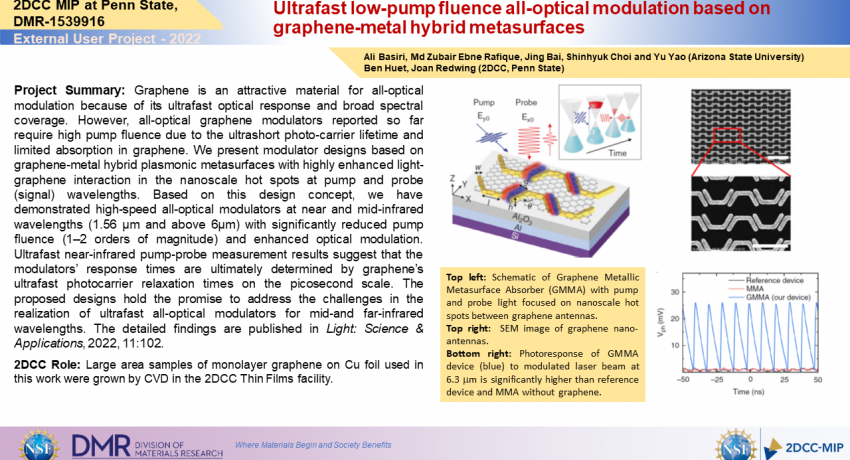What Has Been Achieved:
Design and demonstration of an ultrafast optical modulator operating at near-IR and mid-IR based on a graphene metallic metasurface absorber (GMMA) structure.
Importance of the Achievement:
Ultra-fast optical modulation in the mid- and far-IR waveelenghts is highly desirable for molecular spectroscopy, space communication, remote sensing and biomedical diagnostics. Graphene holds great promise for ultra-fast optical modulation from visible to teraherz frequencies due to its linear and gapless dispersion and ultrafast carrier relaxation. The limited absorption in ultra-thin graphene has been a major challenges to development. In this study, graphene was integrated with plasmonic metasurface absorbers to enhance light-graphene interaction. The mid-IR all-optical optical modulator, to our best knowledge, is the first experimental demonstration of high-speed all-optical modulators for wavelengths beyond 6 μm with a pump fluence of <70 μJ cm−2.
Unique Feature(s) of the MIP that Enabled this Achievement:
Synthesis of high-quality monolayer graphene on copper foil by CVD technique.
Publication:
Ali Basiri, Md Zubair Ebne Rafique, Jing Bai, Shinhyuk Choi, Yu Yao, Light: Science & Applications (2022) 11:102. DOI:10.1038/s41377-022-00787-8
This research was supported in part by the AFOSR YIP under Grant no. FA9550–16–1–0183, the National Science Foundation under grant ECCS-1809997 and 2DCC-MIP national user facility under Grant no. DMR-1539916, and Arizona State University startup funds provided to Y.Y. The devices were fabricated in the NanoFab and Eyring Materials Center (EMC) at Arizona State University. Access to the NanoFab and/or EMC was supported, in part, by the NSF contract ECCS-1542160.
Credits/Names: Ali Basiri, Md Zubair Ebne Rafique, Jing Bai, Shinhyuk Choi and Yu Yao (Arizona State University) Ben Huet, Joan Redwing (2DCC, Penn State)
Download PDF Version: 1539916_2DCCMIP_2022_Ultrafast low-pump fluence all-optical modulation.pdf
Year of Research Highlight: 2022
Select a Highlight Type: User Highlight
